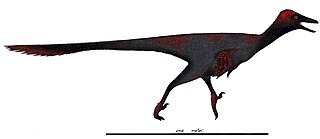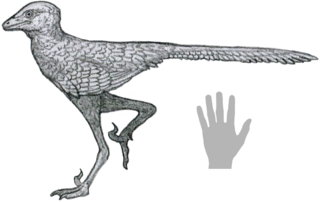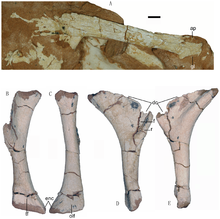
Troodontidae is a clade of bird-like theropod dinosaurs. During most of the 20th century, troodontid fossils were few and incomplete and they have therefore been allied, at various times, with many dinosaurian lineages. More recent fossil discoveries of complete and articulated specimens, have helped to increase understanding about this group. Anatomical studies, particularly studies of the most primitive troodontids, like Sinovenator, demonstrate striking anatomical similarities with Archaeopteryx and primitive dromaeosaurids, and demonstrate that they are relatives comprising a clade called Paraves.

Adasaurus is a genus of dromaeosaurid dinosaur that lived in Asia during the Late Cretaceous period about 70 million years ago. The genus is known from two partial specimens found in the Nemegt Formation of Mongolia that were partially described in 1983 by the paleontologist Rinchen Barsbold.

Sinornithoides is a genus of troodontid theropod dinosaurs containing the single species Sinornithoides youngi. S. youngi lived during the Early Cretaceous. It measured approximately one meter long (3.3 ft). It lived in Inner Mongolia, China, and probably ate invertebrates and other small prey. They lived in what is now Mongolia, which was part of Laurasia.

Bagaceratops is a genus of small protoceratopsid dinosaurs that lived in Asia during the Late Cretaceous, around 72 to 71 million years ago. Bagaceratops remains have been reported from the Barun Goyot Formation and Bayan Mandahu Formation. One specimen may argue the possible presence of Bagaceratops in the Djadochta Formation.
Tugulusaurus is a genus of coelurosaurian theropod dinosaur that belongs to the Alvarezsauroidea. It is known from the Early Cretaceous Tugulu Group in the Urhe area of the People's Republic of China. It was one of the first members of Alvarezsauria ever discovered.

Sinovenator is a genus of troodontid dinosaur from China. It is from the early Cretaceous Period.

Sinusonasus is a genus of dinosaurs from the Early Cretaceous Period, recovered from the Yixian Formation. It lived in what is now the Liaoning Province of China. Sinusonasus was a theropod, specifically a troodontid dinosaur.

Tsaagan is a genus of dromaeosaurid dinosaur from the Djadokhta Formation of the Late Cretaceous of Mongolia.
The Bayin-Gobi Formation is a geological formation in Inner Mongolia, north China, whose strata date back to Albian of the Early Cretaceous period. Dinosaur remains are among the fossils that have been recovered from the formation.

The Bayan Mandahu Formation is a geological unit of "redbeds" located near the village of Bayan Mandahu in Inner Mongolia, China Asia and dates from the late Cretaceous Period. Laid down in the Campanian, it is dated somewhat uncertainly to between 75 and 71 mya.

Linheraptor is a genus of dromaeosaurid dinosaur which lived in what is now China in the Late Cretaceous. It was named by Xu Xing and colleagues in 2010, and contains the species Linheraptor exquisitus. This bird-like dinosaur was less than 2 m (6.5 ft) long and was found in Inner Mongolia. It is known from a single, nearly complete skeleton.

Linhenykus is an extinct genus of alvarezsaurid theropod dinosaur from the Late Cretaceous of Inner Mongolia, China. It is the most basal known member of the Parvicursorinae. The genus gets its name from Linhe, a city near the site where the fossil was first found and Greek nykus, "claw". The specific name is derived from Greek monos, "single", and daktylos, "finger", a reference to the fact that it is the only known non-avian dinosaur to have had but a single digit.

Xiaotingia is a genus of anchiornithid theropod dinosaur from Middle Jurassic or early Late Jurassic deposits of western Liaoning, China, containing a single species, Xiaotingia zhengi.

Philovenator is an extinct genus of troodontid paravian dinosaurs from the Wulansuhai Formation of Inner Mongolia, China. Its specific name honors Phillip J. Currie.

Wulatelong is an extinct genus of basal oviraptorid dinosaur known from the Late Cretaceous Wulansuhai Formation of Bayan Mandahu, Linhe District of Inner Mongolia, northern China. It contains a single species, Wulatelong gobiensis.

Gobivenator is an extinct genus of troodontid theropod dinosaur known from the late Campanian Djadokhta Formation of central Gobi Desert, Mongolia. It contains a single species, Gobivenator mongoliensis. G. mongoliensis is known from a single individual, which represents the most complete specimen of a Late Cretaceous troodontid currently known.

This timeline of troodontid research is a chronological listing of events in the history of paleontology focused on the troodontids, a group of bird-like theropod dinosaurs including animals like Troodon. Troodontid remains were among the first dinosaur fossils to be reported from North America after paleontologists began performing research on the continent, specifically the genus Troodon itself. Since the type specimen of this genus was only a tooth and Troodon teeth are unusually similar to those of the unrelated thick-headed pachycephalosaurs, Troodon and its relatives would be embroiled in taxonomic confusion for over a century. Troodon was finally recognized as distinct from the pachycephalosaurs by Phil Currie in 1987. By that time many other species now recognized as troodontid had been discovered but had been classified in the family Saurornithoididae. Since these families were the same but the Troodontidae named first, it carries scientific legitimacy.

Jianianhualong is a genus of troodontid theropod dinosaur from the Early Cretaceous of China. It contains a single species, Jianianhualong tengi, named in 2017 by Xu Xing and colleagues based on an articulated skeleton preserving feathers. The feathers at the middle of the tail of Jianianhualong are asymmetric, being the first record of asymmetrical feathers among the troodontids. Despite aerodynamic differences from the flight feathers of modern birds, the feathers in the tail vane of Jianianhualong could have functioned in drag reduction whilst the animal was moving. The discovery of Jianianhualong supports the notion that asymmetrical feathers appeared early in the evolutionary history of the Paraves.

Daliansaurus is a genus of small troodontid theropod dinosaur, measuring approximately 1 metre long, from the Early Cretaceous of China. It contains a single species, D. liaoningensis, named in 2017 by Shen and colleagues from a nearly complete skeleton preserved in three dimensions. Daliansaurus is unusual in possessing an enlarged claw on the fourth digit of the foot, in addition to the "sickle claw" found on the second digit of the feet of most paravians. It also has long metatarsal bones, and apparently possesses bird-like uncinate processes. In the Lujiatun Beds of the Yixian Formation, a volcanically-influenced region with a cold climate, Daliansaurus lived alongside its closest relatives - Sinovenator, Sinusonasus, and Mei, with which it forms the group Sinovenatorinae.

Liaoningvenator is a genus of troodontid theropod dinosaur from the Early Cretaceous of China. It contains a single species, L. curriei, named after paleontologist Phillip J. Currie in 2017 by Shen Cai-Zhi and colleagues from an articulated, nearly complete skeleton, one of the most complete troodontid specimens known. Shen and colleagues found indicative traits that placed Liaoningvenator within the Troodontidae. These traits included its numerous, small, and closely packed teeth, as well as the vertebrae towards the end of its tail having shallow grooves in place of neural spines on their top surfaces.





















